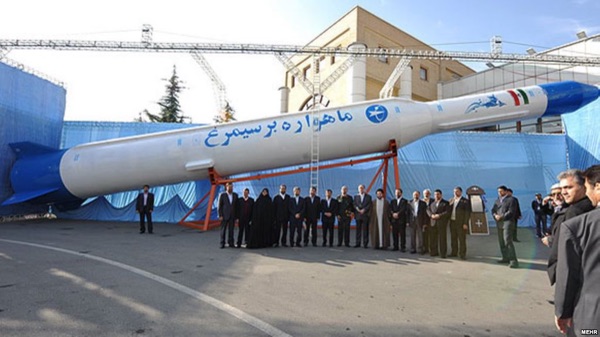Forty years of revolution, ten years of spaceflightby Henk H.F. Smid
|
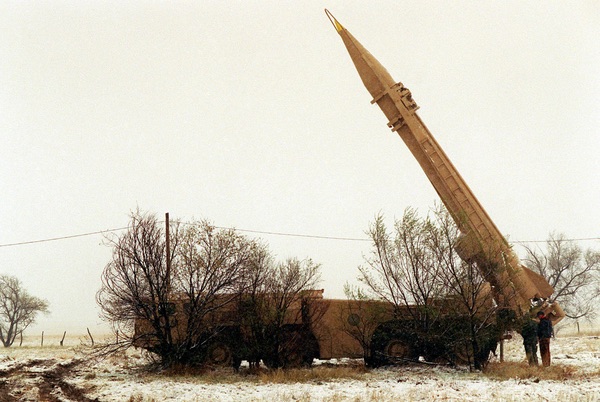 A SCUD-B missile. (credit: Wikipedia) |
Background on Iran’s weapons programs
Since the early 1970s, Iran has focused on developing a strong ballistic missile capacity and this has been an important part of Iran’s defense and deterrence strategy. After all, huge learning costs have been paid. During the war with Iraq (1980–1988), Saddam Hussein aimed his missiles not only at Iranian troops but also at Iranian cities, including Tehran, Tabriz, Isfahan, and Shiraz. Iran was not prepared and had no answer. Only after Iran had acquired missiles from abroad could it effectively retaliate, including by attacking Baghdad. The international community did little to nothing to stop this “War of the Cities.”
| The necessary development of a satellite launching capacity was immediately regarded by the West as a veiled offensive missile program. |
A second reason for Iran’s armaments strategy is the 40-year period of bilateral and multilateral sanctions. As a result, Iran not only no longer has financial reserves to buy weapons abroad, such as modern military aircraft, but it is not allowed to do that either. Regionally, Israel, Saudi Arabia, and the United Arab Emirates are amply equipped with modern weapons, provided mainly by the United States, the United Kingdom and France. A third reason may be that while ballistic missiles are sometimes seen as poor man’s weapons, in Iran they give the government respect. After all, despite all opposition, Iran has managed to create a large, in-house-produced arsenal of missiles that may not be the most effective or far-reaching, but will hurt if used.
Iran’s space program has developed from a feeling that the country is being harassed by the West. The purchase or co-development of necessary geostationary communication satellites was thwarted by the sanctions. Even Russia eventually dropped out. Purchase of commercial space imagery, needed for defense strategies but also for purely civilian tasks, was prohibited by the sanctions. However, satellite images were amply made available to countries surrounding Iran. If Iran wanted to survive, it had to launch its own space program. The necessary development of a satellite launching capacity was immediately regarded by the West as a veiled offensive missile program. In addition, having observation satellites was considered to be detrimental to the states in the Middle East that were kind-hearted to the West.
What is inextricably linked to the development of missiles is Iran’s nuclear program. Iranian leadership has pursued nuclear energy technology since 1950. It was partly encouraged by the Atoms for Peace program of US President Dwight D. Eisenhower (1957) and made steady progress with the help of the West for more than two decades. However, this aid ended after the Iranian revolution (1979) because the West was concerned about what else the Iranians could do with this technology. Iran revived its civilian nuclear programs in the 1990s, but when it became known in 2002 and 2003 that Iran was also involved in uranium enrichment research, the international community raised the alarm. After all, that was not necessary for peaceful civilian use and would indicate the development of a nuclear weapon. Iran has always rejected the allegations that it wants to develop an atomic bomb. In 2007, the US intelligence services stated that Iran had ended its nuclear weapons program in 2003, but the White House (under President Bush) warned that Iran was still pursuing an atomic bomb. Distrust of Iran’s nuclear ambitions was strengthened when it was announced in 2009 that a second uranium enrichment plant had been built in secret, near the holy city of Qom.
Parallel to these developments, there was a constant diplomatic endeavor to solve the problems: Iran would not build a nuclear bomb, in exchange for lifting the sanctions. Without going into the complexity of this, it turned out to be possible to get the Joint Comprehensive Plan of Action (JCPOA) signed in 2015 (under President Obama) and the sanctions could be suspended. In 2019, the United States unilaterally cancelled the JCPOA (under President Trump) and more intensive unilateral sanctions came back into effect. All this leads to a deterioration in the political field (not all signatories of the JCPOA agree with the American decision), economic field (Iran’s economy is heading for a meltdown), and lack of clarity about the status quo (Iran is now, in strategic areas, “going underground.”) This is not the place to investigate why the probably best decision-making regarding the “Iran problem” has failed, politically. This article examines Iran’s military ballistic missile program and Iran’s development of independent access to space through space launch vehicles, where it overlaps and why it may be controversial.
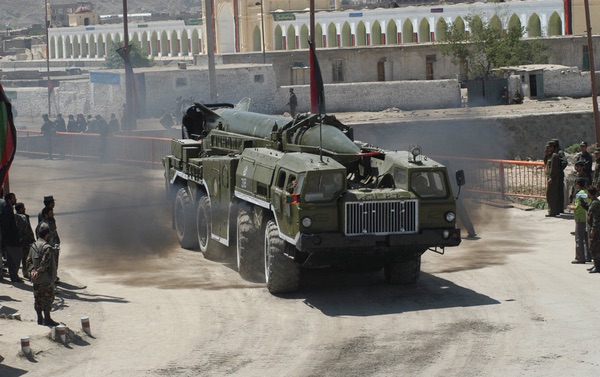 An Iranian Shahab-1 missile. (credit: MDAA) |
Iran’s military missile program
Prior to the 1979 revolution, Iran, rich in oil revenues—Iran did not participate in the oil boycott after the 1973 Arab-Israeli war against countries that had helped Israel—sought to fulfil the dram of the Shah to be the most militarily influential country in the Middle East and South Asia. This suited the Americans well. Iran, together with Saudi Arabia, had to form a regional focal point from which America could safeguard its strategic interests in that area. The Iranian regime significantly increased its military spending, with the result that the Iranian Air Force was by far the strongest in the region and the Shah committed himself to buying all kinds of weapon systems abroad (mainly in the US) and laying a basis for self-sufficiency.
| Many of Iranian developments from ballistic missile to launcher for space launches are still shrouded in secrecy. |
Founded in 1974, the Defence Industries Organization, part of the Iranian War Ministry, began developing and testing short-range unguided artillery missiles. The plan to build and expand a missile capacity was further consolidated through cooperation with Israel. Before the fall of the Shah regime in 1979, Israel was involved in a project involving billions of dollars, and in which modern ground-to-ground missiles were adapted for sale to Iran. This project, which was named “Project Flower,” was one of the six oil-for-arms contracts signed in Tehran in 1977. Iran and Israel did not have diplomatic ties at that time, but there was plenty of trade. Both countries benefitted from Project Flower. For Israel in particular, the guaranteed supply of oil from an important Muslim country was paramount. The Islamic Revolution of 1979 changed all of that and the ground-to-ground rockets, partly paid for in oil, were never delivered.
The Islamic Revolution was a turning point for Iran in many ways with major changes, not only in domestic and foreign politics, but also in its defense strategy. While Iran was almost entirely dependent on the US and Europe in terms of weapons, the new republic could suddenly no longer buy weapons, ammunition, and spare parts there. Military training programs were stopped and foreign advisers and technicians were recalled. Iran’s military industry was still in its infancy and time was needed for technological development, training, and infrastructure. When the war with Iraq broke out, the Iranian military lacked almost everything because domestic politics had been given priority— consequences of the revolution.
At the beginning of the war, the weakened Iranian air force was unable to protect the army and civilian population from Iraqi attacks with planes and missiles. This led to the notion that Iran’s rocket capacity had to be scaled up quickly. Iran started importing SCUD-Bs from Libya, Syria, and later North Korea. SCUD-Bs were tactical ballistic missiles that had been developed by the Soviet Union and were frequently exported to friendly countries. However, they were inaccurate and did not represent much militarily. The missiles were mainly used because the unpredictability of these weapons caused fear among military forces and the population. They were, therefore, a morale boost for the Iranians who could finally do something back to the Iraqis.
From 1985 to 1987, Iran purchased 20 SCUD-Bs from Libya, 12 from Syria, and 120 from North Korea, including all necessary items to deploy the missiles. Between 1988 and 1994, Iran purchased another 150 to 200 SCUD-Bs from North Korea. Iran launched almost 100 SCUD-Bs against Iraq in the Iran-Iraq war. The multimillion-dollar contract with North Korea was the start of years of military cooperation and technology exchange between the two countries and resulted in an Iranian industrial infrastructure that was needed to be able to build and operationalize its own version of the SCUD-B.
Iran called its own version of this rocket the Shahab-1. The North Korean SCUD-B variant that was imported by Iran was called Hwasong-5 by the Koreans. The Shahab-1 is almost identical to this rocket and only differs in the use of parts and materials that were more readily available in Iran. The Shahab-1 is almost 11 meters long and with a diameter of 88 centimeters. The launch weight is approximately 5,800 kilograms. The rocket’s range depends on the warhead and is between 290 and 330 kilometers. Warheads can be tactical atomic bombs, chemical or biological weapons, or high-explosive (HE) warheads. For guidance, the rocket uses internal navigation which achieves a target accuracy of 450 meters CEP (circular error probable.) The single-stage rocket uses liquid propellants and is launched from a transporter-erector-launcher.
The North Korean Hwasong-6 is based on the Russian SCUD-C and was also imported by Iran, 100 to possibly 170 in 1997. The rocket was named Shahab-2 when it was taken into production in Iran in 1998. The differences with its predecessor are a slightly higher launch weight of 6,100 kilograms, reduced warhead mass of 770 kilograms, but a considerable improvement in range, to 500 kilometers. The target accuracy was 500 meters CEP. The warhead probably consists of an HE warhead, but nuclear, chemical or biological weapons are not excluded.
Iran tested an improved version of the Shahab-2 in 2010, which it called the Qiam-1. The Qiam-1 looks a lot like the Shahab-2 but it has a different nose cone and the tail fins are missing, which suggests, among other things, an improved guidance system. In 2017, the Iranians used this rocket in combat operations in Syria against ISIS. The Qiam-1 can launch a 750-kilogram warhead over a distance of 700 to 800 kilometers.
| Several states have converted ballistic missiles to space launch vehicles, or developed both technologies in parallel. However, space launch vehicles have never been converted to ballistic missiles. |
In the mid-1990s, Iran purchased the North Korean No Dong-1 rocket and used it to develop Iran’s first medium range ballistic missile (MRBM), called Shahab-3. The rockets are strikingly similar, both in appearance and in performance. With an operational distance of around 1,300 kilometers for the Shahab-3, Israel and western Saudi Arabia are within reach. Since the rocket was put into operation in 2003, Iran has been working on it continuously. The capacities listed in open sources are probably not reliable. Further new versions were announced by Iran with follow-up designations—Shahab-3A, -3B, -3D and -3M—or with new names such as Qadr-1, Ghadr-1 (2007) and Emad (2015). However, some of these have only existed on drawing boards and there is no clarity about all these variations. That there are variations in appearance is clear through photos of test launches and parades in Tehran. It is beyond the scope of this article to discuss all variants. Importantly, the Shahab-3 has been used as the basis for Iran’s space launch program. Names used are Kavoshgar-1 (sounding rocket), IRIS, and Safir. Of these rockets, the IRIS has never been launched.
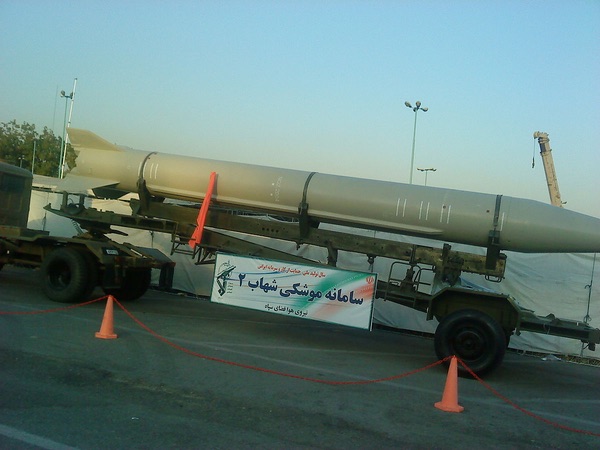 An Iranian Shahab-2 missile. (credit: Wikipedia) |
Iran’s space program
Many of Iranian developments from ballistic missile to launcher for space launches are still shrouded in secrecy. The development of its own space launch vehicle, which could be used to launch its indigenous satellites, started after the establishment of the Iranian Space Agency in 2004. On February 25, 2007, the Iranian state television announced “that a spacecraft missile with an unspecified payload was successfully launched.” This is considered the first launch of an Iranian space-related missile. However, Iranian President Ahmadinejad later stated that the launch had failed. Iran had already launched a satellite (Sina-1) into space with the aid of a Russian launcher from the Plesetsk Cosmodrome on October 27, 2005.
The technology of placing payloads into space was put into practice, among other things, by launching suborbital sounding rockets. The first rocket was the Kavoshgar-1 on February 4, 2008. This two-stage solid propellant rocket had a scientific payload that reached a height of around 200 kilometers and made measurements in the atmosphere on the way back. Several state-controlled media provided different information about this launch, which did not make it any clearer. Through December 14, 2013, at least seven Kavoshgar sounding rockets were launched, most of which had a biological payload, often with rodents and turtles on board, but also with monkeys. This made Iran the sixth country to conduct experiments with animals in space.
The launching of satellites into space was first tested on February 2, 2009. The Iranians then succeeded in orbiting a working satellite, called Omid. The Safir rocket used for this launch was derived directly from the Shahab-3. In fact, the Safir is a Shahab-3 rocket (first stage 13.5 meters) with a small second stage (8.5 meters) placed on top of it. The rocket is 22 meters long, has a diameter of 1.25 meters, and has a launch weight of about 27 tonnes. The Safir uses small steering motors and steering vanes in addition to the engine exhaust for steering. The Safir is capable of putting a 50-kilogram satellite into a 300-kilometer orbit.
A second space launch vehicle developed by Iran is the Simorgh. This is a two-stage liquid propellant rocket for launching satellites weighing 250 kilograms into orbits 500 kilometers high. The satellite can be equipped with a third stage. The first stage has a diameter of 2 to 2.3 meters and the second stage 1.25 meters. The rocket is 27 meters long and has a launch weight of 70 to 87 tonnes. After a first suborbital test in 2016, two failed launches followed: July 27, 2017, with the Toloo satellite (second stage failure), and January 15, 2019, with the Payam satellite (third stage failure.)
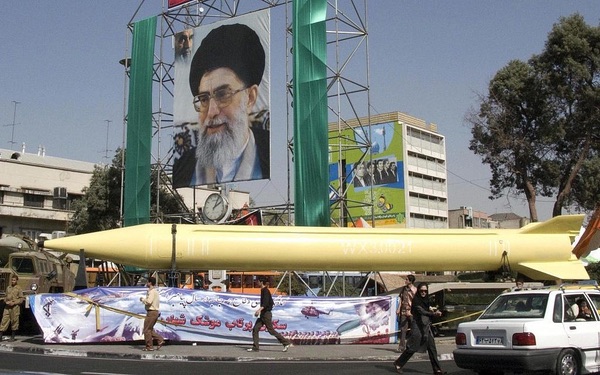 An Iranian Shahab-3 missile. (credit: Times of Israel) |
The controversy: ballistic missiles versus space launch vehicles
Ballistic missile technology has been developed by many states since the Second World War. Several states have converted ballistic missiles to space launch vehicles, or developed both technologies in parallel. However, space launch vehicles have never been converted to ballistic missiles. Such missiles need sufficient speed (4 to 7.8 kilometers per second) to place the warhead into a ballistic trajectory that leads to the target, a trajectory that often goes through space.
To return through the atmosphere without burning up, specific reentry technology is required. This technology has been tested by Iran with its Kavoshgar sounding rocket launches. Space launch vehicles need a much faster speed (about 9.3 kilometers per second) to orbit a satellite.
| If Iran actually pursues an ICBM, it will not be developed from space launch vehicle technology. The current Iranian space launch vehicles are based on much older (SCUD) technology that is unsuitable for ICBMs. |
Ballistic missiles are often solid-propellant rockets, which can be moved and launched quickly, while space launch vehicles are, for the vast majority, liquid-propellant rockets. These are much more efficient, but often much more laborious, especially if the rocket has to be filled with non-sustainable propellants shortly before launch. The SCUD, however, uses longer-lasting propellants, namely kerosene and nitric acid. The difference between ballistic missiles and space launch vehicles is therefore mainly in the mission: warhead versus satellite. The rockets are not readily interchangeable.
On January 3, 2019, US Secretary of State Mike Pompeo announced that Iran was getting ready to launch several space launch vehicles. He also claimed that these vehicles used almost the same technology as ballistic missiles and were therefore a threat to international security. This claim is not entirely true, but not entirely false either. Iran’s missile program is based on the Soviet SCUD ballistic missile that Iran mainly bought from North Korea in the 1980s. This SCUD system has been developed by countries such as Iran, Iraq, Pakistan, and North Korea into offensive missile systems for warfare. Iraq and North Korea also modified these systems, by clustering and stacking, into long-distance systems. The Al Abid of Iraq came to nothing, but the Taepodong rockets of North Korea are at the basis of their current Hwasong-15 rocket system that, with a range of up to 13,000 kilometers, can (theoretically) reach the mainland of America. The Taepodong-2, on the other hand, is labelled as a space launch vehicle developed from a ballistic missile.
Iran developed two space launch vehicles, Safir and Simorgh, in the same way, by extending and stacking with their Shahab-3. Both are liquid-propellant two-stage rockets. North Korea sold the Hwasong-10 ballistic missile system, with a range of 2,500 kilometers, to Iran, which they then called Khorramshahr. Apart from this, Iran and North Korea have collaborated on much more missile technology than can be mentioned in this article.
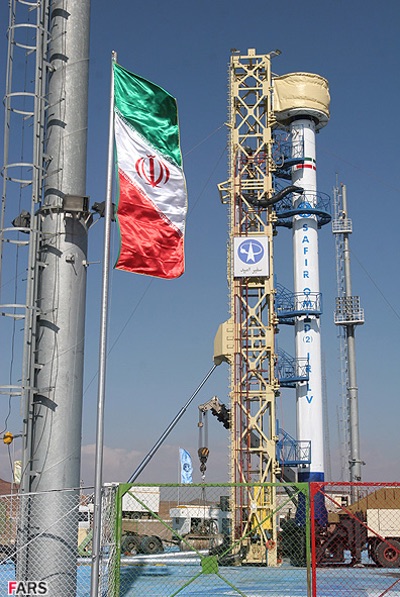 A Safir launch vehicle being prepared for launch. (credit: FARS) |
Emerging space state or a threat to world peace?
Iran continues to develop and produce short- and medium-range ballistic missiles, but it does not follow the North Korean path of making long-range military missiles and it adheres to the self-imposed maximum distance of 2,000 kilometers. However, cooperation with North Korea and testing of the Khorramshahr means that Iran must be deemed capable of developing an intercontinental ballistic missile (ICBM) over time that is not based on SCUD technology, the basis of Iran’s space launch vehicle technology. It seems far-fetched that Iran’s space activities can be seen as a secret ballistic missile program, but that does not alter the fact that developments in Iranian rocket technology will make ICBM production possible in the future.
If Iran actually pursues an ICBM, it will not be developed from space launch vehicle technology. After all, the current Iranian space launch vehicles are based on much older (SCUD) technology that is unsuitable for ICBMs. There are also no indications that Iran is developing a space launch vehicle capability based on Khorramshahr technology in order to get an ICBM that way.
If Iran’s ballistic missile program is already a threat to peace in the Middle East, then Iran’s space launch vehicle program is certainly not. The Iranian launch vehicle program is focused on technology (still Shahab-3 engines for the Simorgh) that is certainly not ideal for long-distance military applications. Mike Pompeo’s concern, based on current space launch vehicle technology, that such vehicles represent a threat to international security is therefore unfounded.
Appendix
This article has used, among other open sources, the IISS Strategic Dossier: The International Institute for Strategic Studies, Iran’s Ballistic Missile Capabilities, A net assessment, London, UK, May 2010, ISBN 978-0-86079-205-5.
Iran – Ballistic Missiles and Space Launch Vehicles. [SCS]
| Name | Range (km) | Payload (kg) | AOC* | Rocket type* |
|---|---|---|---|---|
| Shahab-1 | 290-330 | 985 | 1985 | SRBM |
| Shahab-2 | 500 | 700 | 1997 | SRBM |
| Kavoshgar-1 | Suborbital | < 350 | 2006 | SLV |
| Ghadr-1 | 1,900 | 800 | 2007 | MRBM |
| Shahab-3 | 1,300 | 1,200 | 2007 | MRBM |
| Safir-1 | Orbital | 65 | 2009 | SLV |
| Emad | 1,700 | 750 | 2015 | MRBM |
| Qiam-1 | 700 | 500 | 2017 | SRBM, |
| Simorgh | Orbital | 350 | Tbd | SLV |
AOC = Assessed Operational Capability
MRBM = Medium Range Ballistic Missile
SRBM = Short Range Ballistic Missile
SLV = Space Launch Vehicle
Iran – Successful satellite launches. [SCS]
| Satellite | Weight | Date launched | Launch Vehicle | Launch Site | Orbit |
|---|---|---|---|---|---|
| Sina-1 | 170 kg | 2005-10-27 | Kosmos-3M | Plesetsk (Russia) | 699 x 678 km 96.5° |
| Omid | 27 kg | 2009-02-02 | Safir-1 | Semnan (Iran) | 246 x 381 km 55.7° |
| Rasad-1 | 15 kg | 2011-06-15 | Safir-1B | Semnan (Iran) | 233 x 271 km 55.6° |
| Navid | 50 kg | 2012-02-03 | Safir-1 | Semnan (Iran) | 275 x 374 km 56.0° |
| Fajr | 50 kg | 2015-02-02 | Safir-1B | Semnan (Iran) | 134 x 156 km 55.5° |
Note: we are temporarily moderating all comments submitted to deal with a surge in spam.
